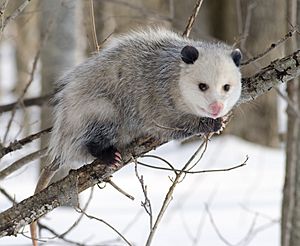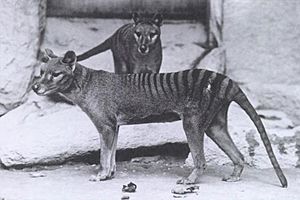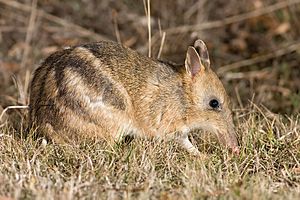List of monotremes and marsupials facts for kids
Mammals are amazing animals that have hair or fur and feed their babies milk. Scientists divide mammals into two main groups based on how they have their babies:
- Egg-laying mammals: These are called monotremes. They are very unique because they lay eggs, just like birds or reptiles!
- Live-birthing mammals: These are called therians. They give birth to live young. This group is then split into two smaller groups:
* Pouched mammals: These are marsupials. Their babies are born very tiny and then grow inside a special pouch on the mother's body. * Placental mammals: These are eutherians. Their babies develop fully inside the mother's body, connected by a special organ called a placenta.
This article will explore the fascinating world of monotremes and marsupials!
Contents
Monotremes: The Egg-Laying Mammals
Monotremes are a small but special group of mammals found only in Australia and New Guinea. They are known for laying eggs instead of giving birth to live young. After the eggs hatch, the mothers feed their babies milk, just like other mammals.
Platypus
The Platypus (Ornithorhynchus anatinus) is one of the most famous monotremes. It has a unique duck-like bill, webbed feet, and a beaver-like tail. Platypuses live in rivers and streams, hunting for small water creatures.
Echidnas
Echidnas are spiny anteaters, looking a bit like porcupines. There are several types:
- Short-beaked echidna (Tachyglossus aculeatus)
- Western long-beaked echidna (Zaglossus bruijnii)
- Eastern long-beaked echidna (Zaglossus bartoni)
- Sir David's long-beaked echidna (Zaglossus attenboroughi)
Echidnas use their long snouts and sticky tongues to catch ants and termites.
Marsupials: The Pouched Mammals
Marsupials are mammals whose babies are born very undeveloped. These tiny newborns then crawl into a special pouch on their mother's belly, where they continue to grow and feed on milk until they are ready to emerge. Most marsupials live in Australia, New Guinea, and the Americas.
American Opossums
Opossums are the only marsupials found in North America. They are known for "playing dead" when scared.
- The Virginia opossum (Didelphis virginiana) is a common example.
- Other types include the woolly opossum (Caluromys) and mouse opossum (Marmosa).
Shrew Opossums
Shrew opossums are small, mouse-like marsupials found in South America. They are shy and mostly active at night.
- Examples include the Incan caenolestid (Lestoros inca) and Long-nosed caenolestid (Rhyncholestes raphanurus).
Monito del Monte
The Monito del monte (Dromiciops gliroides) is a tiny marsupial from Chile and Argentina. It's sometimes called a "little monkey of the mountain."
Marsupial Moles
Marsupial moles are amazing creatures that live underground in the deserts of Australia. They are blind and use their strong claws to dig through sand.
- The Northern marsupial mole (Notoryctes caurinus)
- The Southern marsupial mole (Notoryctes typhlops)
Marsupial Carnivores
This group includes marsupials that hunt other animals for food.
- The †Thylacine (Thylacinus cynocephalus), also known as the Tasmanian Tiger, was a large carnivorous marsupial that is now sadly extinct.
- The Numbat (Myremecobius fasciatus) is a small, colorful marsupial that mainly eats termites.
- Quolls (Dasyurus) are spotted marsupial carnivores found in Australia and New Guinea.
- The Tasmanian devil (Sarcophilus harrisii) is a famous carnivorous marsupial known for its loud screeches and strong bite.
Bandicoots and Bilbies
These marsupials are mostly found in Australia and New Guinea. They have pointed snouts and strong claws for digging.
- Bilbies (Macrotis) are desert-dwelling marsupials with long ears and tails. The Greater bilby (Macrotis lagotis) is an example.
- Bandicoots (Perameles) are small to medium-sized marsupials. The Eastern barred bandicoot (Perameles gunnii) is one type.
Diprotodont Marsupials
This is a very diverse group of marsupials, meaning "two front teeth." It includes many well-known Australian animals.
Wombats and Koalas
- The Koala (Phascolarctos cinereus) is an iconic Australian marsupial that eats eucalyptus leaves.
- Wombats (Vombatus and Lasiorhinus) are burrowing marsupials with strong bodies. The Common wombat (Vombatus ursinus) is a familiar type.
Possums and Gliders
These marsupials are often found in trees.
- Pygmy possums (Burramys and Cercartetus) are tiny possums.
- Brushtail possums (Trichosurus) and cuscuses (Phalanger, Spilocuscus) are common tree-dwelling marsupials.
- Greater gliders (Petauroides) are amazing marsupials that can glide through the air using a special membrane.
- The Sugar glider (Petaurus breviceps) is a popular small marsupial that can also glide.
- The Honey possum (Tarsipes rostratus) is a tiny marsupial that feeds on nectar and pollen.
Kangaroos, Wallaroos, and Wallabies
This group includes some of the most famous Australian marsupials, known for their powerful hind legs and hopping movement.
- Tree-kangaroos (Dendrolagus) are unique kangaroos that live in trees in New Guinea and parts of Australia.
- Kangaroos (Macropus) are the largest marsupials. Examples include the Red kangaroo (Macropus rufus) and Eastern grey kangaroo (Macropus giganteus).
- Wallabies (Macropus subgenus Notamacropus) are smaller than kangaroos. The Agile wallaby (Macropus agilis) is one kind.
- Quokkas (Setonix brachyurus) are small, friendly wallabies found on Rottnest Island.
- Rat-kangaroos (Aepyprymnus, Bettongia, Potorous) are smaller, often nocturnal marsupials. The Eastern bettong (Bettongia gaimardi) is an example.
Images for kids
See also
- List of marsupials of Western Australia
- Mammal classification
- List of prehistoric mammals
- List of recently extinct mammals
- List of placental mammals








